The Theory of Flight
-
Airfoils and Lift

An airfoil is a device which gets a useful reaction from air moving over its surface. When an airfoil is moved through the air, it is capable of producing lift. Wings, horizontal tail surfaces, vertical tails surfaces, and propellers are all examples of airfoils.
Generally the wing of small aircraft will look like the cross-section of the figure above. The forward part of an airfoil is rounded and is called the leading edge. The aft part is narrow and tapered and is called the trailing edge. A reference line often used in discussing airfoils is the chord, an imaginary straight line joining the extremities of the leading and trailing edges.
Angle of Incidence: The angle of incidence is the angle formed by the longitudinal axis of the airplane and the chord of the wing. The longitudinal axis is an imaginary line that extends lengthwise through the fuselage from nose to tail. The angle of incidence is measured by the angle at which the wing is attached to the fuselage. The angle of incidence is fixed --it normally cannot be changed by the pilot. (An exception is the Vought F8U Crusader.)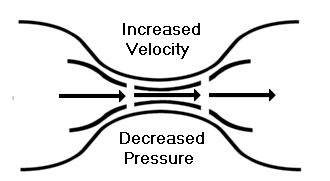
Bernoulli's Principle: To understand how lift is produced, we must examine a phenomenon discovered many years ago by the scientist Bernoulli and later called Bernoulli's Principle: The pressure of a fluid (liquid or gas) decreases at points where the speed of the fluid increases. In other words, Bernoulli found that within the same fluid, in this case air, high speed flow is associated with low pressure, and low speed flow with high pressure. This principle was first used to explain changes in the pressure of fluid flowing within a pipe whose cross-sectional area varied. In the wide section of the gradually narrowing pipe, the fluid moves at low speed, producing high pressure. As the pipe narrows it must contain the same amount of fluid. In this narrow section, the fluid moves at high speed, producing low pressure.
An important application of this phenomenon is made in giving lift to the wing of an airplane, an airfoil. The airfoil is designed to increase the velocity of the airflow above its surface, thereby decreasing pressure above the airfoil. Simultaneously, the impact of the air on the lower surface of the airfoil increases the pressure below. This combination of pressure decrease above and increase below produces lift.
Lift: Probably you have held your flattened hand out of the window of a moving automobile. As you inclined your hand to the wind, the force of air pushed against it forcing your hand to rise. The airfoil (in this case, your hand) was deflecting the wind which, in turn, created an equal and opposite dynamic pressure on the lower surface of the airfoil, forcing it up and back. The upward component of this force is lift; the backward component is drag .
Pressure is reduced is due to the smaller space the air has above the wing than below. Air cannot go through the wing, so it must push around it. The surface air molecules push between the wing and outer layers of air. Due to the bump of the airfoil, the space is smaller and the molecules must go faster. According to Bernoulli's Law, faster air has lower air pressure, and thus the high pressure beneath the wing pushes up to cause lift. -
Flight Control Surfaces - Elevons
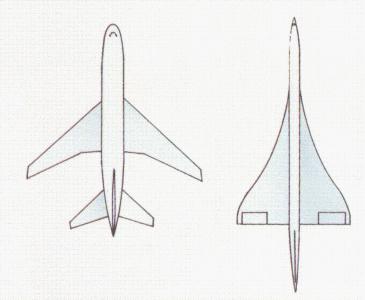
Elevon: Delta winged aircraft can not use conventional 3 axis flight control systems because of their unique delta shape. Therefore, it uses a device called an elevon. It is a combination of ailerons and elevators.
The elevon is used as an aileron. Ailerons control motion along the longitudinal axis. The longitudinal axis is an imaginary line that runs from the nose to the tail. Motion about the longitudinal axis is called roll.
The elevon is also used as an elevator. Elevators control motion along the lateral axis. The lateral axis is an imaginary line that extends crosswise, from wingtip to wingtip. Motion about the lateral axis is called pitch. -
>point to Singapore Aviation forum<
but it's good GK though -
hahahahahaha, i'm reading it now... MC really nothing to do.Originally posted by FireIce:>point to Singapore Aviation forum<
but it's good GK though
I was putting it in that forum... but its about airlines. At least put in chit chat it will go down in a while -
Flight Control Surfaces
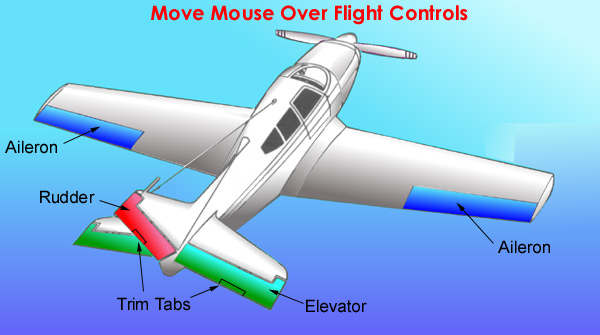
The three primary flight controls are the ailerons, elevator and rudder
Ailerons: The two ailerons, one at the outer trailing edge of each wing, are movable surfaces that control movement about the longitudinal axis. The movement is roll. Lowering the aileron on one wing raises the aileron on the other. The wing with the lowered aileron goes up because of its increased lift, and the wing with the raised aileron goes down because of its decreased lift. Thus, the effect of moving either aileron is aided by the simultaneous and opposite movement of the aileron on the other wing.
Rods or cables connect the ailerons to each other and to the control wheel (or stick) in the cockpit. When pressure is applied to the right on the control wheel, the left aileron goes down and the right aileron goes up, rolling the airplane to the right. This happens because the down movement of the left aileron increases the wing camber (curvature) and thus increases the angle of attack. The right aileron moves upward and decreases the camber, resulting in a decreased angle of attack. Thus, decreased lift on the right wing and increased lift on the left wing cause a roll and bank to the right.
Elevators: The elevators control the movement of the airplane about its lateral axis. This motion is pitch. The elevators form the rear part of the horizontal tail assembly and are free to swing up and down. They are hinged to a fixed surface--the horizontal stabilizer. Together, the horizontal stabilizer and the elevators form a single airfoil. A change in position of the elevators modifies the camber of the airfoil, which increases or decreases lift.
Like the ailerons, the elevators are connected to the control wheel (or stick) by control cables. When forward pressure is applied on the wheel, the elevators move downward. This increases the lift produced by the horizontal tail surfaces. The increased lift forces the tail upward, causing the nose to drop. Conversely, when back pressure is applied on the wheel, the elevators move upward, decreasing the lift produced by the horizontal tail surfaces, or maybe even producing a downward force. The tail is forced downward and the nose up.
The elevators control the angle of attack of the wings. When back pressure is applied on the control wheel, the tail lowers and the nose raises, increasing the angle of attack. Conversely, when forward pressure is applied, the tail raises and the nose lowers, decreasing the angle of attack.
Rudder: The rudder controls movement of the airplane about its vertical axis. This motion is yaw. Like the other primary control surfaces, the rudder is a movable surface hinged to a fixed surface which, in this case, is the vertical stabilizer, or fin. Its action is very much like that of the elevators, except that it swings in a different plane--from side to side instead of up and down. Control cables connect the rudder to the rudder pedals.
Trim Tabs: A trim tab is a small, adjustable hinged surface on the trailing edge of the aileron, rudder, or elevator control surfaces. Trim tabs are labor saving devices that enable the pilot to release manual pressure on the primary controls.
Some airplanes have trim tabs on all three control surfaces that are adjustable from the cockpit; others have them only on the elevator and rudder; and some have them only on the elevator. Some trim tabs are the ground-adjustable type only.
The tab is moved in the direction opposite that of the primary control surface, to relieve pressure on the control wheel or rudder control. For example, consider the situation in which we wish to adjust the elevator trim for level flight. ("Level flight" is the attitude of the airplane that will maintain a constant altitude.) Assume that back pressure is required on the control wheel to maintain level flight and that we wish to adjust the elevator trim tab to relieve this pressure. Since we are holding back pressure, the elevator will be in the "up" position. The trim tab must then be adjusted downward so that the airflow striking the tab will hold the elevators in the desired position. Conversely, if forward pressure is being held, the elevators will be in the down position, so the tab must be moved upward to relieve this pressure. In this example, we are talking about the tab itself and not the cockpit control.
Rudder and aileron trim tabs operate on the same principle as the elevator trim tab to relieve pressure on the rudder pedals and sideward pressure on the control wheel, respectively. -
huh? iz thiz a introductory course for training pilots?

-
tonite refresh ranking liao lehOriginally posted by kopiosatu:I was putting it in that forum... but its about airlines. At least put in chit chat it will go down in a while
dun open so many topics lah...........
-
hmmm when will bar drop?? so many topics opened but small replies...Originally posted by FireIce:tonite refresh ranking liao leh
dun open so many topics lah...........
-
Forces Acting on an Airplane
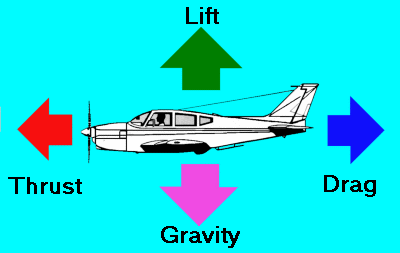
The airplane in straight-and-level unaccelerated flight is acted on by four forces. The four forces are lift, gravity, thrust and drag.
The airplane in straight-and-level unaccelerated flight is acted on by four forces--lift, the upward acting force; weight, or gravity, the downward acting force; thrust, the forward acting force; and drag, the backward acting, or retarding force of wind resistance.
Lift opposes gravity.
Thrust opposes drag.
Drag and weight are forces inherent in anything lifted from the earth and moved through the air. Thrust and lift are artificially created forces used to overcome the forces of nature and enable an airplane to fly. The engine and propeller combination is designed to produce thrust to overcome drag. The wing is designed to produce lift to overcome the weight (or gravity).
In straight-and-level, unaccelerated flight, (Straight-and-level flight is coordinated flight at a constant altitude and heading) lift equals weight and thrust equals drag, though lift and weight will not equal thrust and drag. Any inequality between lift and weight will result in the airplane entering a climb or descent. Any inequality between thrust and drag while maintaining straight-and-level flight will result in acceleration or deceleration until the two forces become balanced. -
even engineers and technicians need to know the basicsOriginally posted by poon cho tang:huh? iz thiz a introductory course for training pilots?

-
The Swept Wing

The whole idea of sweeping an aircraft's wing is to delay the drag rise caused by the formation of shock waves. The swept-wing concept had been appreciated by German aerodynamicists since the mid-1930s, and by 1942 a considerable amount of research had gone into it. However, in the United States and Great Britain, the concept of the swept wing remained virtually unknown until the end of the war. Due to the early research in this area, this allowed Germany to successfully introduce the swept wing in the jet fighter Messerschmitt ME-262 as early as 1941.
Early British and American jet aircraft were therefore of conventional straight-wing design, with a high-speed performance that was consequently limited. Such aircraft included the UKGloster Meteor F.4 , the U.S. Lockheed F-80 Shooting Star and the experimental U.S. jet, the Bell XP-59A Airacomet.
After the war German advanced aeronautical research data became available to the United States Army Air Force (USAAF) as well as Great Britain. This technology was then incorporated into their aircraft designs. Some early jets that took advantage of this technology were the North American F-86 Sabre, the Hawker Hunter F.4 and the Supermarine Swift FR.5.
Not to be outdone, the Soviet Union introduced the swept wing in the Mikoyan Mig-15 in 1947. This aircraft was the great rival of the North American F-86 Sabre during the Korean War. -
the first pic v familar.. think I saw it during my 2 weeks stay at Youth Flying Club.

You repair aeroplane ar?
Put the helicopter one lah.. think its more interesting to know how helli fly.. hover... etc...
the main rotor.. tail rotor.... horizontal stablizer... tail shaft...
horizontal stablizer... tail shaft... -
Axis of Rotation
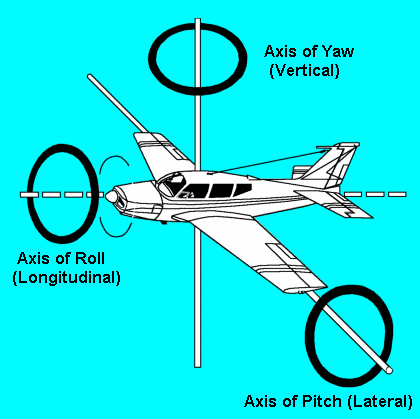
An airplane may turn about three axes. Whenever the attitude of the airplane changes in flight (with respect to the ground or other fixed object), it will rotate about one or more of these axes. Think of these axes as imaginary axles around which the airplane turns like a wheel. The three axes intersect at the center of gravity and each one is perpendicular to the other two.
Longitudinal Axis: The imaginary line that extends lengthwise through the fuselage, from nose to tail, is the longitudinal axis. Motion about the longitudinal axis is roll and is produced by movement of the ailerons located at the trailing edges of the wings.
Lateral Axis: The imaginary line which extends crosswise, wing tip to wing tip, is the lateral axis. Motion about the lateral axis is pitch and is produced by movement of the elevators at the rear of the horizontal tail assembly.
Vertical Axis: The imaginary line which passes vertically through the center of gravity is the vertical axis. Motion about the vertical axis is yaw and is produced by movement of the rudder located at the rear of the vertical tail assembly. -
Helicopter one ah... Hmmm where should i start the topic???? hahhahahaOriginally posted by X-men:the first pic v familar.. think I saw it during my 2 weeks stay at Youth Flying Club.
You repair aeroplane ar?
Put the helicopter one lah.. think its more interesting to know how helli fly.. hover... etc...
the main rotor.. tail rotor.... horizontal stablizer... tail shaft...
horizontal stablizer... tail shaft...
That one has to open as Theory of Helicopter Flight -
the wings need to be at an angle to lift the aircraft a not?
-
Composite Materials

Various composite materials are used in structures such as the Boeing 777 because of their strength, and weight savings. Composites also offer resistance to fatigue, corrosion and impact damage
Composites are different from metals. They are combinations of materials differing in composition or form. The constituents retain their identities in the composites and do not dissolve or otherwise merge completely into each other although they act together. Reinforced concrete is an excellent example of a composite structure in which the concrete and steel still retain their identities. The steel bars carry the tension loads and the concrete carries the compression loads. In aircraft construction the term composite structures refers to fabric resin combinations in which the fabric is embedded in the resin but still retains its identity.
Advanced composite materials consist of new high strength fibers embedded in an epoxy matrix. These composites provide for major weight savings in airplane structures since they have high strength to weight ratios. When replacing aluminum structure with graphite/epoxy composite weight reductions of 20% or better are possible. Weight reduction is the greatest advantage of composite material and is one of the key items in decisions regarding its selection. other advantages over conventional structure include its high corrosion resistance and its resistance to damage from cyclic loading (fatigue).
The major disadvantage of using advanced composite materials in airplane construction is the relatively high cost of the materials.
Composite Hybrids: Hybrids are made by the addition of some complementary material such as fiberglass or kevlar to the basic carbon fiber/epoxy matrix. The added materials are used to obtain specific material characteristics such as greater fracture toughness and impact resistance, and should be considered for areas subject to foreign object damage. The addition of carbon / epoxy to fiberglass structure is used to provide additional stiffness. -
yes. it cannot be flat.Originally posted by 01024G:the wings need to be at an angle to lift the aircraft a not?
That is why planes have flaps to help generate lift. -
Interesting thread.
 Bookmarking it.
Bookmarking it. 
-
thanks for the support~ let's see who's interested in helicopter flight?Originally posted by X-plicit:Interesting thread. Bookmarking it.
Bookmarking it. 

-
Hahahaha all these are theory of Super Puma liao... see who interested to knowOriginally posted by X-men:the first pic v familar.. think I saw it during my 2 weeks stay at Youth Flying Club.
You repair aeroplane ar?
Put the helicopter one lah.. think its more interesting to know how helli fly.. hover... etc...
the main rotor.. tail rotor.... horizontal stablizer... tail shaft...
horizontal stablizer... tail shaft...
-
You know it reminds me of the times when I read the whole manual for Flight Sims.

-
hahaha, hey i heard one of the games, the whole book is practically the training manual for flying.Originally posted by sillyme:You know it reminds me of the times when I read the whole manual for Flight Sims.
anyway, helicopter flight is more complicated... dunno if i should just start a topic for fun. -
step 1 - go to high ground
step 2 aim for the ground and jump off
step 3 miss -
that would be theory of mrt suicidesOriginally posted by Bamboozler:step 1 - go to high ground
step 2 aim for the ground and jump off
step 3 miss -
Helicopter one more complicated mah..Originally posted by kopiosatu:Helicopter one ah... Hmmm where should i start the topic???? hahhahaha
That one has to open as Theory of Helicopter Flight